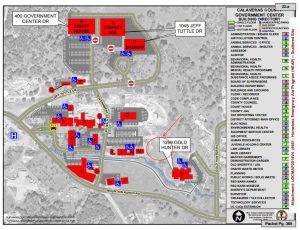San Andreas, CA – Plans are well underway to specifically address emergency homeless shelter and support services in Calaveras County.
Earlier this week the board of supervisors formally approved using a portion of the government center campus, located at 891 Mountain Ranch Road for one of two shelter locations where tiny homes will be built as temporary residences for those in need who have plans in place to address their issues. The area, located between the Behavioral Health clinic and library, is well-situated as it is close to resources and caseworkers.
The other site, operated by Calaveras County Homeless Task Force partner, the Blue Mountain Coalition for Youth and Families (BMYCF) in West Point, is located in West Point. At the end of May, the supervisors voted unanimously to support the necessary rezoning process at an estimated cost of under $5,000 from the General Fund. As reported here, it was part of several actions taken to kickstart the project and further enable future grant eligibility.
Overall, the pilot project calls for a total of ten tiny houses across the two sites. Each will have a shower, bathroom, and small kitchen area. As part of the program, individuals who are temporarily placed through a coordinated entry system in the shelter units will receive intensive case management support using the Housing First Model.
Now in the bidding and administrative planning process, organizers anticipate the scattered shelter project should be under contract by winter.
“There is no one-size-fits-all solution for homelessness…no magic wand we can wave and make it all go away or make it all better. It is one foot in front of the other and one person to another person that is going to get ahead of this,” District 2 Supervisor and Board Chair Jack Garamendi tells Clarke Broadcasting.
Housing, Homelessness The Most Complex Challenges
“There is no challenge facing a local government that is more complex than housing and homelessness,” he continues. “Every person who is homeless has a story and a reason how they got there.”
While some of the county’s 200 or so homeless are in that position by choice, he adds that most are not. Fortunately, state funding now pipelining into local communities are providing opportunities to help people down on their luck transition back into a home and contributing to a community.
Among the monies coming in is a roughly $302,000 funding chunk from a one-time Homeless Emergency Aid Program (HEAP) award of $1.2 million, in partnership with the four-county Central Sierra Continuum of Care (COC).
The homeless task force advocated for and got approval for the abovementioned scattered-site tiny home emergency shelter pilot project, as it was considered a way to uniquely address the immediate emergency needs of homeless individuals and those at imminent risk of homelessness.
Garamendi acknowledges the statewide housing crisis, which includes a sore lack of workforce housing, is also a somewhat related issue that the county must also locally address.
“We have more housing needs. But for those who are down on their luck, we want to be able to help them. I think we are doing that, and I think the Continuum of Care, taking a look at all the issues that can impact an individual, and trying to address them is a good thing for our community to do, especially since we are working with our nonprofits and religious communities to do that…it is really a partnership.”
He adds, “I really want to credit Health and Human Services for really working hard on their outreach, not just to the clients that we will serve — but to the community that will be our partners in serving them.”

